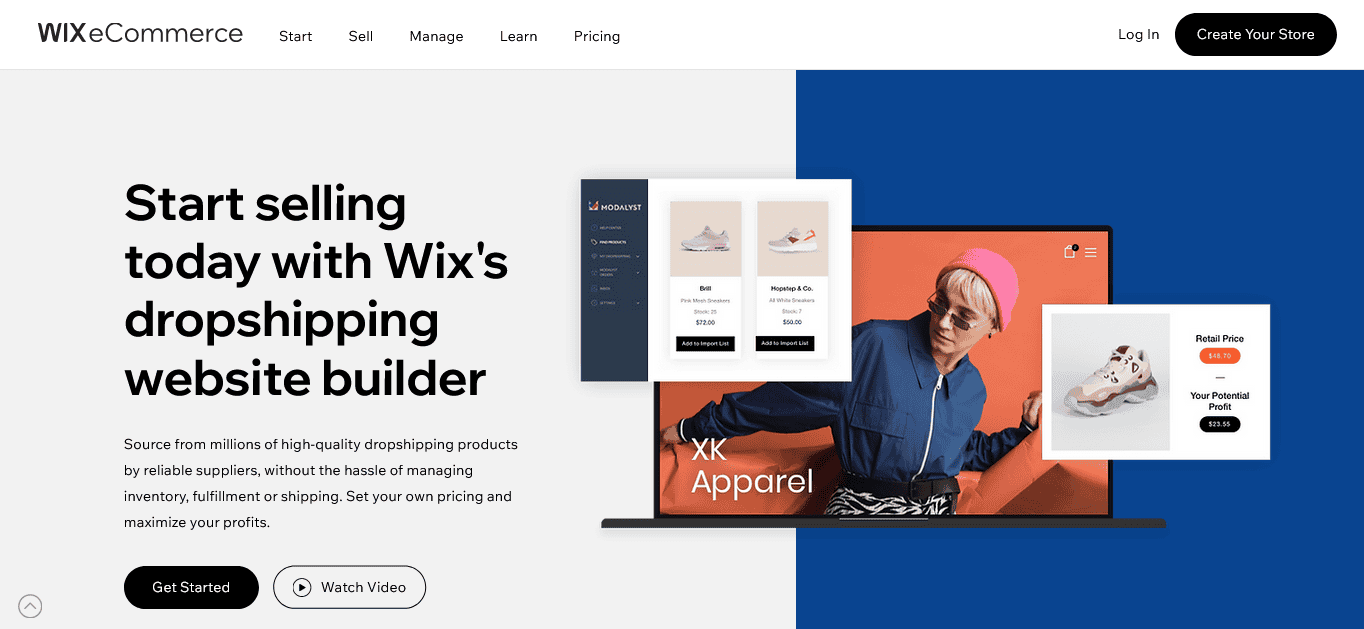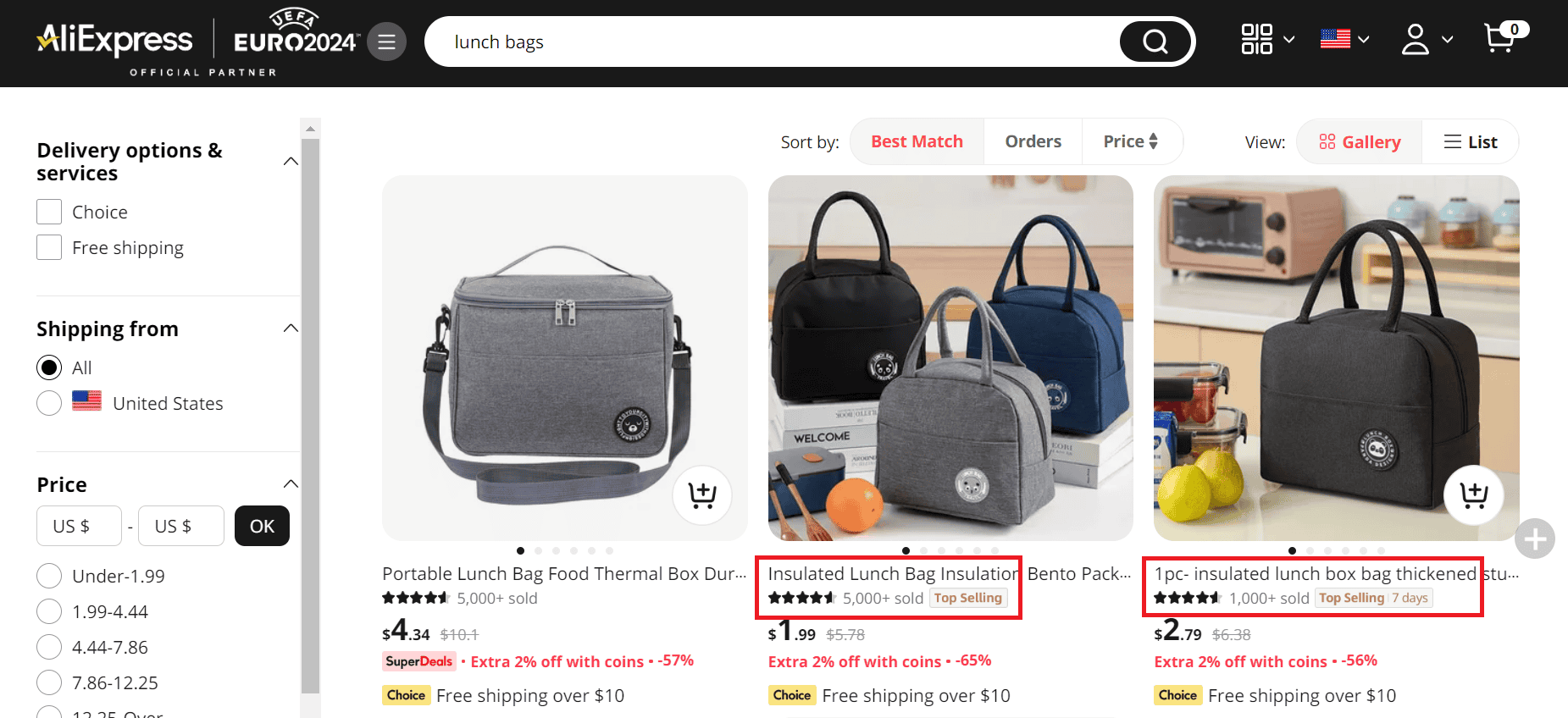According to Forbes, there are an estimated 24 million eCommerce stores worldwide, including big names like Shopify. This number is expected to continue growing for the next few years. eCommerceGuide also reports that 58.4% of internet users buy something online every week, which means one thing—eCommerce isn’t slowing down anytime soon.
If you are a retailer wondering how to start a successful eCommerce business without gambling your life’s savings, dropshipping is the business model you need.
So, what is dropshipping?
It is an order fulfillment business model in which you don’t keep the products you sell in stock. Instead, you purchase the item from a third-party supplier and have it shipped directly to the customer. This business model offers you flexibility, reduced overhead costs, and more time to focus on what’s most important as an online retailer—marketing!
In this blog post, we cover the following:
- What is dropshipping
- The benefits of dropshipping and how it differs from traditional retail
- How to set up a dropshipping business
- Top dropshipping platforms
Let’s dive in!
Table of Contents
Key Takeaways
- Setting up a dropshipping business involves research, selecting a platform, vetting suppliers, creating a product listing, and developing a strategic launch plan that will gain traction.
- Ensure you choose the right platform. Shopify and WooCommerce are popular options with unique features for different business needs.
- Use directories, trade shows, sample orders, and reviews to find and vet reliable suppliers.
- Use high-quality images, detailed descriptions, SEO optimization, and social proof for effective product listings.
- Ensure digital marketing, SEO best practices, social media engagement, influencer partnerships, and email marketing are crucial for attracting and retaining customers.
What Is Dropshipping: Understanding the Basics
Dropshipping is an eCommerce model where the seller doesn’t keep the product they sell in stock. Instead, orders are delivered directly to the customer from the manufacturer or dropshipping supplier.
When a store sells a product using the dropshipping business model, it purchases the item from a third party and has it shipped directly to the customer. As a result, the seller doesn’t have to handle the product directly.
You may be asking, “How does dropshipping work”? To understand the process better, here’s a breakdown of what dropshipping is and how the dropshipping business model works:
- You set up an eCommerce store and choose products to list from a dropshipping supplier.
- A customer places an order on your website and pays the retail price that you’ve set.
- After the customer orders, you forward the order and customer details to the dropshipping supplier and pay the supplier’s wholesale price.
- The dropshipping supplier ships the product directly to the customer under your branding.
- You will be responsible for customer interactions and support any inquiries or issues.
So, a dropshipper is concerned with the client-facing side of retailing rather than the supply chain.
Comparison with traditional retail models
Dropshipping, as a model, is different from the traditional eCommerce business model. They have a different set of characteristics and advantages. Here’s a comparison between conventional retail models and dropshipping.
| Dropshipping | Traditional retail models |
| Dropshippers never stock inventory, reducing the risk and cost of unsold products | Traditional retailers purchase and store inventory |
| Dropshipping has lower initial costs because purchases are made only after a sale is secured. | It requires a significant upfront investment to purchase stock |
| Dropshippers rely on suppliers to manage these operations. | Traditional retailers handle shipping and logistics themselves |
| Dropshipping margins are typically lower due to the supplier taking a share of the profits. | Traditional retail might have higher profit margins due to bulk purchasing discounts |
Critical Components of a Dropshipping Business
Like every other business, the dropshipping business model has significant players that make it up—dropshipping suppliers, dropshippers, and consumers. Let us take a look at each component.
The dropshipping supplier
They are also called manufacturers or third-party suppliers. They provide the products, manage inventory, and ship items directly to customers on behalf of the seller. Examples include AliExpress and Alibaba. When starting as a dropshipper, getting a reliable third-party supplier is essential to ensure product quality and order fulfillment efficiency. This way, you build customer trust and loyalty over time.
The dropshipper
The dropshipper is the middleman between the manufacturer and the consumer. They are also called retail sellers or just sellers. They own online stores that market and sell products and allow consumers to place orders. Then, they pass the order on to the dropshipping supplier for order fulfillment.
For a dropshipping retailer, the focus is on marketing, customer acquisition, and customer service. To be successful, you must choose the right products, set competitive prices, and provide excellent customer service.
Customers
They are the third on this chain. Customers purchase products from online sellers. Their satisfaction depends on product quality, low shipping costs, delivery time, and the seller’s customer service.
Read also: The International Dropshipping Guide for Newbies
The Benefits of Dropshipping
Dropshipping offers several advantages, making it an attractive model for online retailers looking to start an online business or expand their existing sales channels. So, let’s look at some of the benefits of dropshipping.
Low startup costs and minimal overhead
Since you do not purchase products upfront, there are no costs for storing, managing, or insuring inventory in your eCommerce business. This also means you can start a dropshipping business with limited funds, as you only buy products after a sale.
Without a physical store or warehouse space, rent, utilities, and staffing costs associated with traditional retail will be unnecessary.
Flexibility in product offerings and scalability
Dropshipping is flexible, allowing you to experiment with market trends by adding or removing products without financial repercussions.
New products can be easily added to your dropshipping store website without additional investments. The best part is that the business can quickly scale as your sales grow since suppliers handle the order fulfillment process.
Reduced risk with no need for inventory management
Dropshipping cancels out financial risk to a large extent. Since you get the products when a customer orders them directly from the dropshipping companies, you’re not left with unsold or expired products, which mitigates potential losses and reduces financial risk.
Read also: How to Minimize Shipping Times in Dropshipping
How To Set Up a Dropshipping Business
Starting a dropshipping business involves several steps, from market research to launching your online store. We have outlined a step-by-step guide to help you through the process.
Step 1: Do your market research
After deciding on the dropshipping business model, the first step is to identify a niche with high demand and low to moderate competition. Then, analyze potential products on eCommerce platforms, social media, and online marketplaces to find bestsellers. There are several ways to find bestsellers on online marketplaces. Here’s how to find bestsellers on AliExpress, for instance.
How to find bestsellers on AliExpress
First, go to AliExpress.com, then click on More.
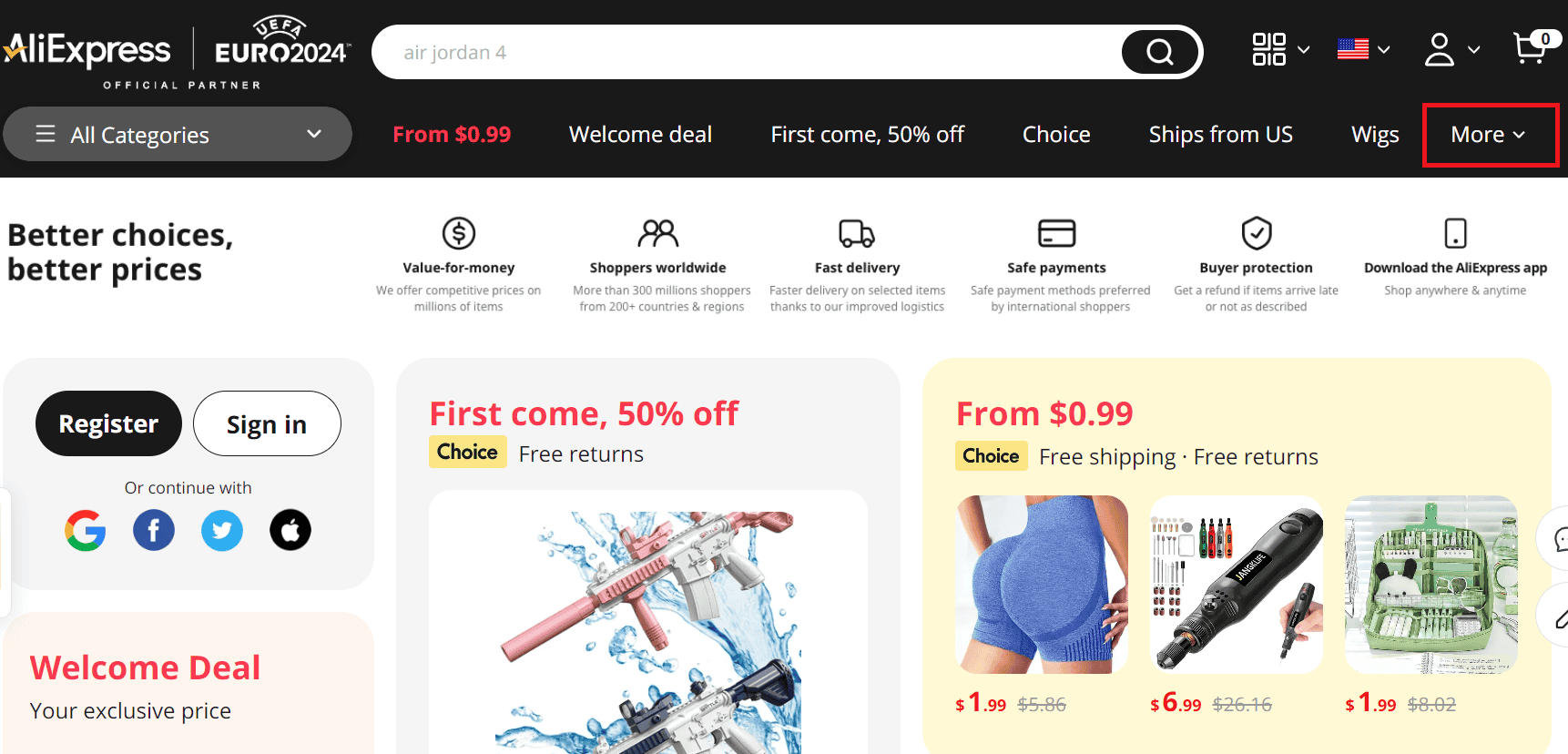
Next, click on SuperDeals.
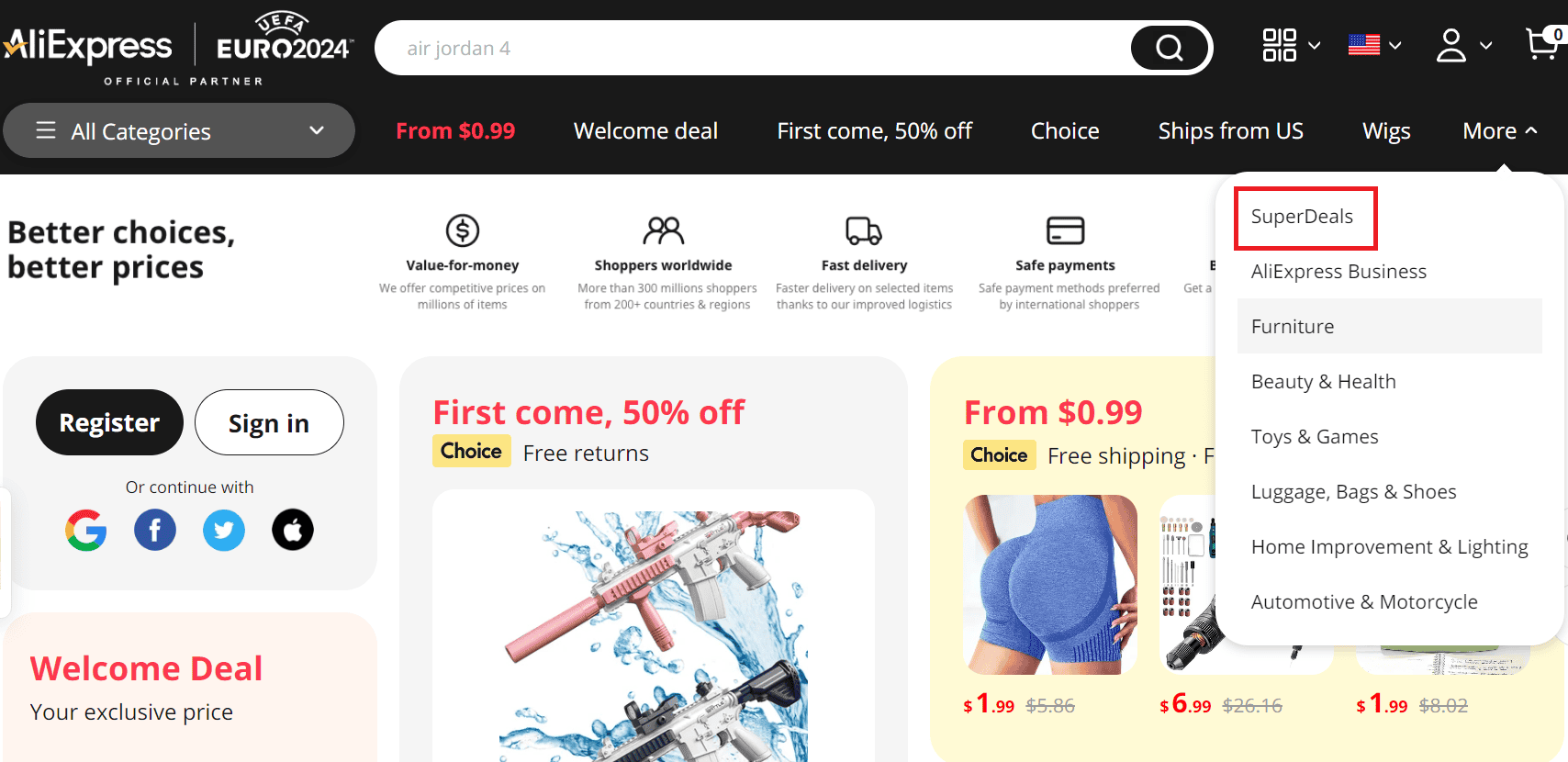
Then, you’ll find a list of top sellers to give you a clue of what people are buying.

Alternatively, you can use this method to find the top sellers in a particular niche: Go to More on the AliExpress homepage.

Next, click on a category or niche. In this case, I clicked on Furniture.
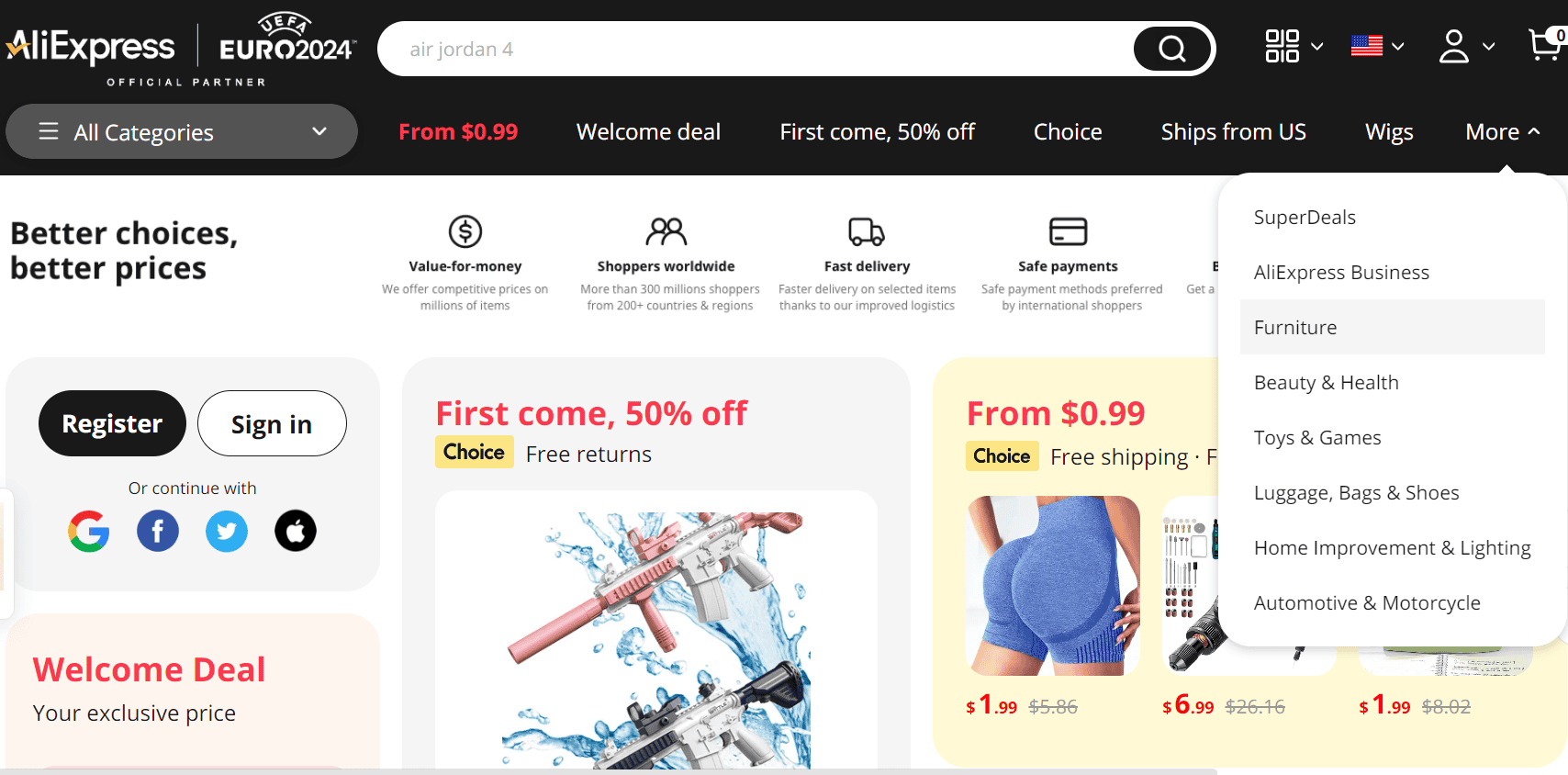
Then you’ll see all the best-selling products in this category.
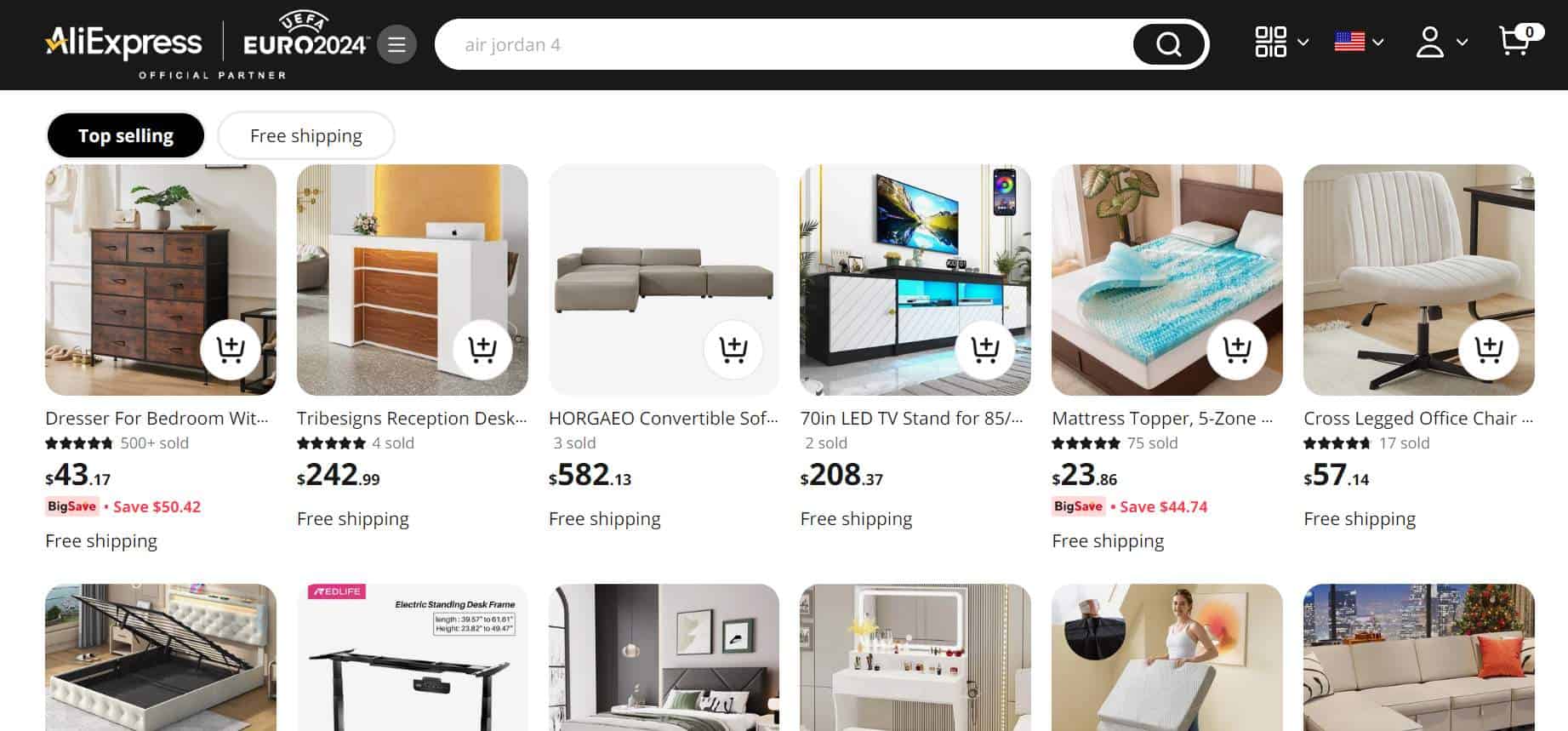
Repeat this process for other top-selling eCommerce platforms to understand what people worldwide are most interested in. This will give you a guide for the products to list in your dropshipping store.
How to find bestsellers using keyword research tools
Another way to market research is to use keyword research tools like Google Trends to get insight into customer behavior.

Using Google Trends, go to the Explore Menu, then add your search term, and you’ll be able to see its interest over time. For instance, here’s the search result for ‘kitchen furniture’ on Google Trends for the past 12 months. It’s still in demand.
Step 2: eCommerce platform selection
Once you have completed the market search and business plan, choose an eCommerce platform that suits your budget, technical skills, and business needs. Shopify and WooCommerce are two popular options, each with its own set of features and benefits.
Step 3: Website creation
Thirdly, build your online store using the chosen platform, customizing the design to align with your brand. Ensure the website is user-friendly, responsive, and optimized for search engines.
Step 4: Supplier sourcing
There are several suppliers for the dropshipping business. However, you must find dropshipping suppliers who offer quality products, meet delivery deadlines, and have flexible return policies. Not all third-party suppliers are entirely reliable, and you don’t want to sell products that don’t meet users’ expectations.
It is essential to look for a trustworthy supplier. Here are some ways to find reliable suppliers.
- Directories: Use supplier directories like SaleHoo, Worldwide Brands, or Alibaba to find potential suppliers for your retail store. SaleHoo has over 8,000+ prevetted suppliers.
- Trade shows: Attend trade shows and industry events to meet suppliers and check their products firsthand.
- Sample orders: Place sample orders to test product quality, shipping times, and the packaging process.
- Reviews and references: Check online reviews and ask for references to gauge the supplier’s reliability and customer service quality.
Read also: 6 Dropshipping Email Marketing Best Practices (2024)
Step 5: Setting up payment and shipping
Configure payment gateways to accept transactions and set up shipping options. Take into account the shipping fees and time provided by your suppliers.
Step 6: Launch
Once your store is stocked with products and tested for functionality, you can launch it. Before a full launch, consider soft-launching to a smaller audience to gather initial feedback.
Read also: How to Choose Dropshipping Products to Sell Online in 2024
Choosing the Right eCommerce Platform for Your eCommerce Store
Several factors must be considered before deciding on an eCommerce platform to ensure the success of your dropshipping business. These factors include ease of use and setup, cost, integration with eCommerce tools, SEO and marketing features, scalability, and customization.
Here are some of the platforms that you can choose from for your dropshipping business.
Shopify
Shopify is a leading eCommerce platform known for its ease of use and extensive features. It offers integrations with numerous dropshipping apps such as Spocket, Printful, Oberlo, and marketplaces, simplifying product sourcing and order fulfillment. Additionally, Shopify provides customizable templates, secure payment processing, and built-in SEO tools, making it a comprehensive solution for eCommerce businesses.
On Shopify, you can create your online store with professional-looking themes. Shopify also provides built-in tools for dropshipping services to help you process customers’ orders, manage shipping and purchasing inventory, and securely accept payments.
WooCommerce
Built as a plugin for WordPress, WooCommerce is a flexible and customizable eCommerce platform for dropshipping services. It offers a wide array of extensions and integrations for dropshipping, including supplier management, inventory sync, and order tracking.
With its scalability and open-source nature, WooCommerce provides ample room for customization. You can create multiple unique and branded stores tailored to your specific needs.
WooCommerce also allows you to manage your project catalog, add new products, update inventory levels, and organize products into categories and tags. You can also effectively process orders, track order status, and manage customer communications, making handling customer service easy.
BigCommerce
BigCommerce is a feature-rich eCommerce platform for dropshipping businesses. It offers seamless integrations with dropshipping apps and provides advanced marketing tools, multi-channel selling capabilities, and responsive themes.
Additionally, BigCommerce prioritizes scalability, making it suitable for businesses with ambitious growth plans. With BigCommerce, you can effectively manage your inventory levels and track stock availability in real-time.
Finally, BigCommerce offers built-in marketing tools and features to help you attract and engage customers, including SEO optimization, email marketing, social media integration, and promotional campaigns.
Wix
Wix is a user-friendly eCommerce platform that enables easy website creation and management. For instance, it has many customizable templates that allow you to design an online store that reflects your brand identity.
Furthermore, Wix allows you to create promotional and email marketing campaigns and optimize your website for search engines (SEO) to increase visibility as an eCommerce retailer. Wix also enables you to import products from suppliers or manually add products to your online store. You can organize products into categories, set prices, and manage product descriptions.
Above all, it offers integrations with apps like Modalyst and Spocket, making it easy to connect with dropshipping suppliers and import products into your store.
Magento
Magento is a powerful open-source platform offering robust dropshipping business features. In addition, the platform allows you to easily manage your product catalog, including adding new products, updating contact information, and categorizing products for easy navigation.
Also, it provides extensive customization options, a broad range of extensions for dropshipping functionalities, and strong SEO capabilities. While Magento requires higher technical expertise, it offers unparalleled flexibility and scalability for ambitious dropshipping ventures.
Finally, Magento can integrate with multiple suppliers and platforms, enabling you to automate data imports, manage orders, and update your inventory in real-time.
Squarespace
Squarespace is a visually appealing platform that offers intuitive website design tools and built-in marketing features. For example, it supports dropshipping through integrations with platforms like Printful and ShipStation, providing a seamless user experience for entrepreneurs and customers.
Additionally, Squarespace’s emphasis on design and user experience makes it an attractive option for visually oriented dropshipping businesses. With Squarespace analytic feature, you can track your store’s performance, monitor sales trends, and make data-driven decisions to grow your business.
Challenges and Solutions in Dropshipping
Like every other business, numerous challenges are encountered along the way. However, success is achieved when the challenges are solved. Here are some of the difficulties encountered in dropshipping.
Handling supplier errors and shipping delays
Dealing with supplier errors and shipping delays is dicey because they may include wrong items, poor product quality, or incorrect packaging. A delay in the shipping process can cause frustration, dissatisfaction, and financial losses on the customer’s side.
Consequently, to address this challenge, establish a clear communication channel with your suppliers. This will help you to state your requirements and vet them before sending them to customers. Finally, a tracking system for shipping delays should be implemented, and open communication with customers about potential delivery delays should be kept to contain expectations.
Maintaining product quality without direct oversight
It is hard to ensure that products meet quality standards and specifications, especially in remote or outsourced manufacturing processes. An effective way to solve this problem is to vet your suppliers before placing an order. That way, you buy only from quality manufacturers.
Strategies for effective communication with suppliers and customers
Here are some effective strategies for effective communication with suppliers and customers.
Establish a dedicated point of contact
Having a fixed point of contact makes the process easy, allowing suppliers to meet you at a particular place. The point of contact will ensure prompt and consistent communication, making it easy for you to address inquiries, resolve issues, and maintain a proactive approach to your dropshipping business.
Utilizing email, phone, and video conferences
By using emails and direct calls, you can facilitate regular interaction with suppliers and customers, allowing you to receive and give real-time updates and feedback. You can also leverage digital platforms and collaboration tools for order management, inventory tracking, and performance analysis to streamline and improve business efficiency.
Utilizing customer relationship management (CRM)
CRM allows businesses to centralize customer data, including purchase history, preferences, and interactions. By leveraging a CRM system like EngageBay, you can access features like lead tracking and management, contributing to a streamlined lead generation effort.
Using a CRM system, you can segment customers based on demographics to improve your communication with them.
Read also: Dropshipping Affiliate Marketing 101: A Step-by-Step Guide
Marketing Strategies for Dropshipping Businesses
Like any online business, dropshipping businesses rely heavily on strategic marketing to attract and retain customers. Below are some effective marketing strategies tailored for dropshipping.
Use digital marketing to drive traffic and sales
Digital marketing is a broad term that describes any activity you use to increase awareness and attract customers online, such as PPC advertising, content marketing, or social media marketing. As a dropshipper, you must attract traffic to your website and generate leads you can nurture over time with email marketing.
One way to do this is by optimizing your website and product listing for organic search. If you have a bigger budget, you can go the faster route and invest in paid search. Facebook ads are a primary way drop-shippers drive traffic to their store and make sales. It doesn’t come as a surprise, as there are 2.9 billion monthly active users.
On Facebook, you can target users based on their interests, gender, age, location and more. According to data from WebFX, Facebook ads cost, on average, $0.26 to $0.30 per click and $1.01 to $3.00 per 1,000 impressions.
However, you can set a daily ad spend limit to work with your marketing budget. However, you get more from Facebook ads when you spend more. Here are some of the reasons why digital marketing is essential for driving sales.
- Targeted advertising: Use platforms like Google Ads and Facebook Ads to reach potential customers who have shown interest in similar products.
- Content marketing: Create valuable content related to your niche to engage customers and drive organic traffic to your website.
- Analytics and monitoring: Use digital marketing analytics to track the performance of your campaigns and adjust strategies accordingly for better ROI.
Use SEO to drive organic search
SEO dropshipping is a great way to drive organic traffic to your dropshipping store. Keyword optimization is critical for SEO, but several other factors must also be considered, like building backlinks and optimizing product titles and meta descriptions. For instance, let’s take a look at this example.
A search for the “best lunch bag for work” resulted in this. I observed that most top searches had a common keyword: insulated lunch box.
Then, I went to AliExpress to search for lunch bags. Again, the top searches and even bestsellers had the same keyword in common—insulated lunch box.
While this isn’t the sole reason why they are the best sellers, it contributes to your success when you find what customers are looking for for a particular product they are searching for and include it in your product description.
In this example, an insulated lunch bag was a priority for people who wanted to buy a lunch box, so including it in your product descriptions increases your chances of being found.
So, to increase the chances of being found on online marketplaces and drop shipping platforms, ensure your product listings and descriptions include keywords potential buyers are looking for.
Tips for creating compelling product listings
Below are some tips to help you create compelling product listings.
- High-quality images: Use high-resolution images that show products from multiple angles.
- Detailed descriptions: Ensure product descriptions are written clearly, highlighting features and benefits. Use relevant keywords in your product titles and descriptions to improve search engine visibility.
- Social proof: Include customer reviews and ratings to build trust and encourage sales. This will help prospective customers see how well you operate and gain confidence.
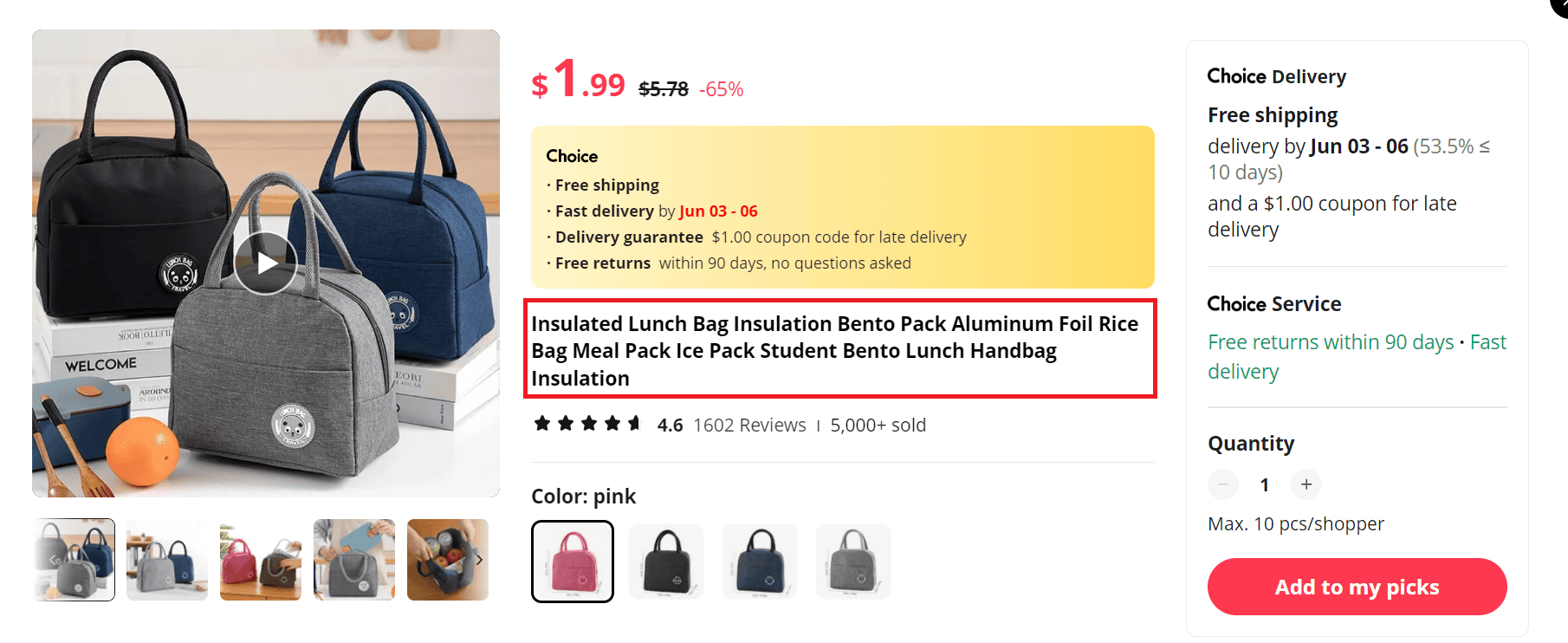
SEO is also important for content marketing, as it allows you to gain visibility and rank on SERPs for specific keywords and products you sell.
Social media and influencer partnerships
According to a marketing report, Dropshipping stores with one social media account generate 32% more revenue than those without one. Using social media to advertise your services goes a long way to help with brand awareness. You can make your social media marketing strategy more formidable by partnering with influencers to improve brand authority and awareness.
Here are some tips for social media and influencer partnerships.
- Engaging content: Share engaging, high-quality content that resonates with your target audience and encourages interaction on platforms like Instagram, Facebook, and Pinterest.
- Influencer marketing: Partner with influencers who align with your brand to tap into their follower base and generate trust and credibility.
- Social media ads: Utilize the advanced targeting options available on social media platforms to reach specific demographics and interests.
- Community building: Create and nurture an online community around your brand to foster loyalty and word-of-mouth referrals.
Improve customer retention and engagement through email marketing
Email marketing is a popular marketing technique for eCommerce companies to nurture leads and build customer relationships. It’s an excellent way to turn one-time purchasers into repeat customers. Here are some tactics you can employ for your dropshipping business.
- Personalized campaigns: Segment your email list and send personalized content and offers to different customer groups.
- Welcome series: Send welcome emails to new subscribers to introduce your brand and set the stage for future communications.
- Abandoned cart reminders: Use automated emails to remind customers of items left in their carts, often including a small discount or incentive to complete the purchase.
- Newsletters and updates: Keep your customers engaged with regular newsletters that share valuable content, new product arrivals, and special promotions.
Technological Enhancements and Tools in Dropshipping
If you offer dropshipping services, you can benefit greatly from various tools and technologies to save more time and improve your business efficiency. Here’s an overview of some tools and software that can help streamline your dropshipping operation.
eCommerce platforms: Shopify, WooCommerce, and BigCommerce offer integrated tools for selling products and managing your product listings, orders, and customer data.
Dropshipping automation: Platforms like Oberlo and Spocket enable seamless product imports, order fulfillment, and shipment tracking, streamlining the dropshipping process.
Customer Relationship Management (CRM): CRM systems like HubSpot, EngageBay, Salesforce, and Zoho CRM help you manage and analyze customer interactions, improving customer relationships and retention.
Analytics and reporting: Tools like Google Analytics, kissmetrics, and Mixpanel provide valuable insights into website traffic, customer behavior, and sales performance.
Impact of AI and automation in managing customer interactions and inventory
Customer interactions: AI-powered chatbots and virtual assistants can handle common customer queries, provide personalized recommendations, and even process orders, improving customer service and freeing human resources for more complex tasks.
Inventory management: AI and machine learning algorithms can analyze your sales data, forecast demand, and optimize inventory levels, reducing the risk of stockouts and overstock situations.
Emerging technologies that could benefit dropshipping businesses
Consistent development aims to help customers have a better experience within the dropshipping ecosystem. Advancements have been made, and here are some of the emerging tech that could benefit your dropshipping business.
Blockchain
Blockchain technology can enhance supply chain transparency, reduce fraud, and streamline payment processes, providing more secure and efficient transactions between drop shippers and suppliers.
Augmented reality (AR)
AR technology can allow customers to visualize products in their environment before making a purchase, enhancing the online shopping experience and reducing the likelihood of returns.
3D printing
As 3D printing technology advances, fast 3D printing service options could offer on-demand manufacturing and customization opportunities, potentially reducing lead times and allowing for more unique product offerings in dropshipping.
Voice commerce
With the increasing adoption of smart speakers and voice assistants, integrating voice commerce capabilities into dropshipping websites could open up new avenues for customer engagement and sales.
Read also: Mastering SEO for Dropshipping: Strategies to Drive Traffic and Revenue
Legal and Ethical Considerations in Dropshipping
Ensuring your dropshipping operations are entirely legal is crucial. This includes understanding the need for a Dropshipping Agreement Contract, conducting thorough research on suppliers and contracts to protect your business, and ensuring compliance with platforms like Amazon.
Here are some common legal issues faced by dropshippers.
- Contractual agreements: Ensuring clear and enforceable contracts with suppliers to define terms of service, pricing, shipping, and return policies.
- Intellectual property infringement: Avoiding the sale of counterfeit or unauthorized products to prevent legal action for trademark and copyright infringement.
- Consumer protection laws: Compliance with consumer protection laws related to product quality, warranties, refunds, and customer rights.
- Data privacy and security: You can safeguard customer information and privacy by adhering to data protection regulations such as GDPR and CCPA.
Importance of transparency with customers
Generally, transparency helps to build trust between two parties, and it works the same in the case of dropshipping. You can manage customers’ expectations and reduce misunderstandings by providing accurate, honest information. Here are some areas you need to ensure transparency with customers.
- Product information: Provide accurate and detailed product information, including materials, dimensions, and country of origin, to allow customers to make informed purchasing decisions.
- Shipping and delivery: Communicate shipping times, costs, and potential delays to manage customer expectations and build trust.
- Return and refund policies: Share refund policies to ensure customers understand their rights and the process for resolving issues.
- Communication: Promptly address customer inquiries and concerns, maintaining open lines of communication to build trust and loyalty.
Read also: How to Build a Dropshipping Brand That Clicks
Real-World Examples of Successful Dropshipping Businesses
There are a good number of companies out there that have employed different tactics and strategies to be successful. By applying specific principles, these companies became successful in their dropshipping endeavor. Here are some case studies.
Oberlo
Oberlo is a dropshipping platform that enables entrepreneurs to find products to sell online and seamlessly import them to their Shopify stores. It offers a wide range of products from suppliers worldwide, allowing entrepreneurs to quickly launch and scale their dropshipping businesses without needing upfront inventory investment.
Oberlo’s success lies in its user-friendly interface, extensive product selection, and integration with Shopify, making it a popular choice among aspiring drop shippers.
Printful
Printful is a dropshipping company specializing in print-on-demand products, including apparel, accessories, and home decor. It allows entrepreneurs to create custom-designed products and sell them through their online stores without holding inventory. Printful handles production, fulfillment, and shipping, allowing entrepreneurs to focus on marketing and growing their businesses.
Printful’s success stems from its high-quality products, fast shipping times, and integration with popular e-commerce platforms like Shopify, Etsy, and WooCommerce.
Zappos
While not a traditional dropshipping business, Zappos initially started as a dropshipping retailer before transitioning to holding inventory. In its early days, Zappos partnered with suppliers to offer a wide selection of shoes and apparel on its website. This allowed Zappos to quickly establish itself as a leading online retailer without the need for significant upfront investment in inventory.
Zappos’ success demonstrates the potential of dropshipping as a viable business model for scaling quickly in the eCommerce industry.
Nomatic
Nomatic is a lifestyle brand that began as a dropshipping business selling travel gear and accessories. By leveraging dropshipping suppliers, Nomatic was able to expand its product line and reach a global audience rapidly. As the business grew, Nomatic transitioned to holding inventory and fulfilling orders in-house, but its success story highlights the effectiveness of dropshipping as a launchpad for eCommerce startups.
Lessons learned from success stories
Here are some lessons to learn from the success stories we have shared.
- Customer-centric approach: Successful drop shippers prioritize understanding and meeting their ‘customers’ needs by maintaining a personal touch during the sales process and providing exceptional customer support.
- Effective supply chain management: Building solid relationships with reliable suppliers and maintaining efficient inventory management.
- Continuous learning and adaptation: Successful dropshippers are agile and open to learning from successes and failures. They continuously adapt to changes in market, technology, and consumer behavior.
Conclusion
Dropshipping is an excellent option for online retailers who want to build profitable e-commerce businesses with minimal start-up funds. It contributes a whopping 34% of sales on Amazon, which means that with the right approach and strategies in place, its profitability is unlimited.
Moreover, dropshipping offers many advantages over more traditional retail business models, such as low startup costs, minimal inventory management, reduced risk, and potential for scalability. You can start today by researching in-demand products to sell, setting up your website, selecting reliable suppliers, and double-down on marketing to generate traffic to your dropshipping store.
Thousands of eCommerce business owners and retailers trust EngageBay for their marketing automation and email marketing needs. You only need to book a demo with one of our experts to get started.
Frequently Asked Questions
1. What are the initial costs involved in starting a dropshipping business?
You should budget for domain registration and hosting, typically $10 to $30 annually for a domain and $5 to $20 per month for hosting. However, you can consider e-commerce platform subscriptions, such as Shopify or WooCommerce, which range from $20 to $30 monthly for basic plans.
2. How do I handle returns and refunds when dropshipping?
Firstly, set clear return and refund policies on your website to manage customer expectations effectively. Secondly, coordinate with your supplier to ensure their return policy aligns with yours. Then, manage customer requests promptly, arrange returns with clear instructions, issue refunds after item inspection, and maintain communication throughout the process for good customer service.
3. Can dropshipping be profitable in a competitive market?
Yes, dropshipping can be profitable in a competitive market by carving out a niche with less competition and focusing on unique or specialized products. Effective marketing strategies and optimizing the customer experience can also differentiate a dropshipping business and attract loyal customers.
4. What are the best practices for choosing a niche in dropshipping?
You should research market trends to find a niche with growth potential and a strong customer base. Analyze competition to ensure the niche is balanced and identify gaps you can fill. Consider your interests and expertise, and evaluate profitability based on factors like pricing, shipping costs, and potential margins.
5. How does dropshipping impact customer service?
Dropshipping’s longer shipping times and inventory control challenges can complicate customer service, emphasizing the need for transparent communication to manage expectations. Coordinating returns and exchanges with third-party suppliers adds complexity, underscoring the importance of proactive problem-solving and a customer-first approach.




